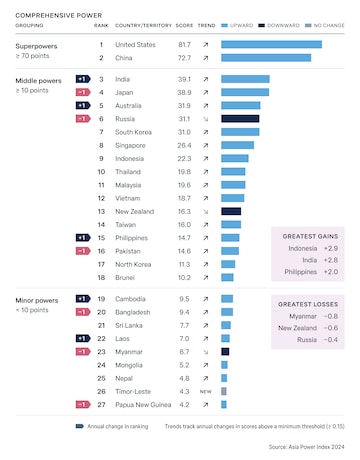This annually announced index, which was launched by the Lowy Institute in 2018, assesses resources and influence to rank the relative power of Asian states. It maps the existing distribution of power as it stands today and tracks changes in the balance of power over time.
The confrontation between superpowers: China against the United States
The fierce competition between Beijing and Washington is at the center of the power contest in Asia.
China’s rise has stalled, the report mentions. Once considered a potential hegemon in the region, China’s economic capacity has stagnated due to slower economic growth and structural challenges.
When it comes to power projection in Asia, China’s military advance has helped it maintain its influence. However, the weakness of economic and defense networks restricts their ability to fully capitalize on their resources.
On the other hand, the report noted that the United States remains resilient. Out of eight parameters, Washington is ahead of China on six, including defense networks and diplomatic influence.
Although Beijing has been closing the military gap since 2018, US alliances with Japan, South Korea and Australia have given it a strong footing in Asia. At its core, the United States continues to wield unparalleled influence in Asia.
The slow and steady rise of India

New Delhi became the third Asian power by surpassing Japan. The report also indicates that the country’s comprehensive power has gradually grown, particularly after the post-COVID economic recovery.
With the increase of 4.2 points in its economic capacity, the country has improved its position. However, its performance does not fully align with the “rise of India” narrative.
India’s low integration into Asia’s frontier economic architecture has hampered the country’s ability to project power. New Delhi’s influence is largely limited to its immediate vicinity, east of the Strait of Malacca.
The report also expects the country’s young population to provide a demographic dividend, in contrast to Beijing’s rapidly aging workforce, giving India more room to grow in the long term.
However, in terms of defense networks, New Delhi fell to ninth place, showing a cautious stance towards improving security cooperation, especially in US-led alliances.

Japan’s strategic change
Japan, once known for its economic and cultural power, is increasingly focusing on defense and security. It has increased its military spending under the leadership of former prime ministers Shinzo Abe and Fumio Kishida and is advancing as a regional security provider.
To bolster its regional influence, the country also signed a Reciprocal Access Agreement with the Philippines in 2024.
However, the report notes that Japan’s economic capacity continues to decline, considering technological competition from South Korea and China. Its aging population could further erode the country’s ability to maintain its historic leadership in the region.
The silent growth of Southeast Asia
Interestingly, Indonesia and the Philippines, Southeast Asia’s two largest economies, are experiencing solid growth. In the report, Indonesia has gained more power than any other country since the creation of the Asia Energy Index in 2018, with an increase of 11%.
Jakarta’s ASEAN presidency in 2023 boosted its diplomatic influence and its growing technological sophistication improved its economic capacity.
Meanwhile, the Philippines jumped to 15th position in the index, overtaking Pakistan. Manila’s growing military cooperation with the United States, along with a diversification strategy toward U.S.-aligned partners, has allowed the country to increase its regional influence.
Australia: Staying stable
According to the report, Australia rose to fifth place, overtaking Russia, which witnessed a decline in influence since its invasion of Ukraine. Leveraging its strong defense networks, especially with the United States and Japan, it remains a highly influential middle power.
Conclusion: the future of power in Asia
The Lowy Institute’s Asia Power Index paints a complex picture of power dynamics in the region. Beijing and Washington remain the most crucial players, but China’s stagnant influence provides opportunities for other powers such as India and Japan to assert themselves.
New Delhi’s rise, though slow, is significant and has long-term potential due to its demographic dividend. The growing influence of Southeast Asia, particularly Indonesia and the Philippines, highlights the changing balance of power in the Indo-Pacific.
Disclaimer:
The information contained in this post is for general information purposes only. We make no representations or warranties of any kind, express or implied, about the completeness, accuracy, reliability, suitability or availability with respect to the website or the information, products, services, or related graphics contained on the post for any purpose.
We respect the intellectual property rights of content creators. If you are the owner of any material featured on our website and have concerns about its use, please contact us. We are committed to addressing any copyright issues promptly and will remove any material within 2 days of receiving a request from the rightful owner.

